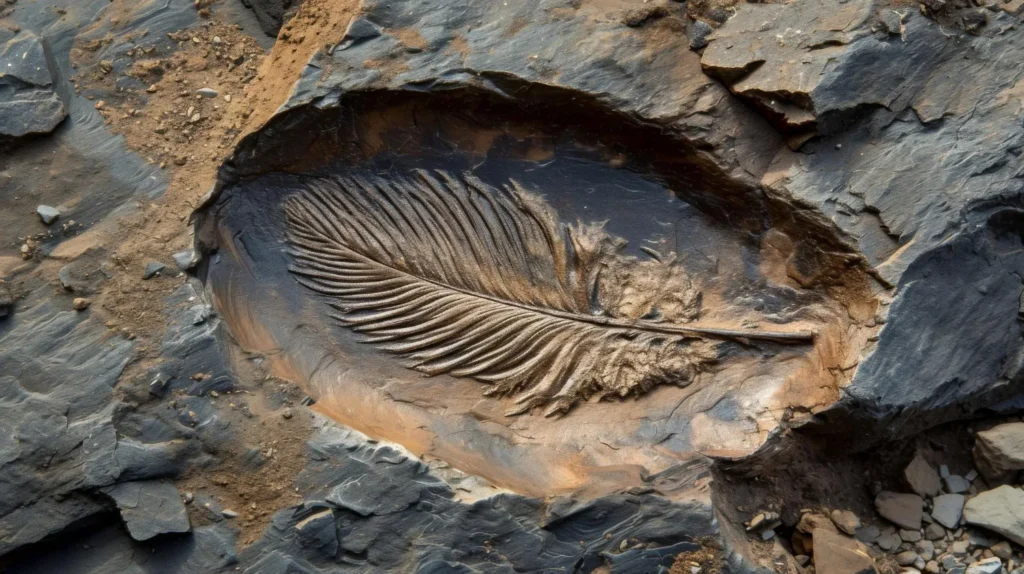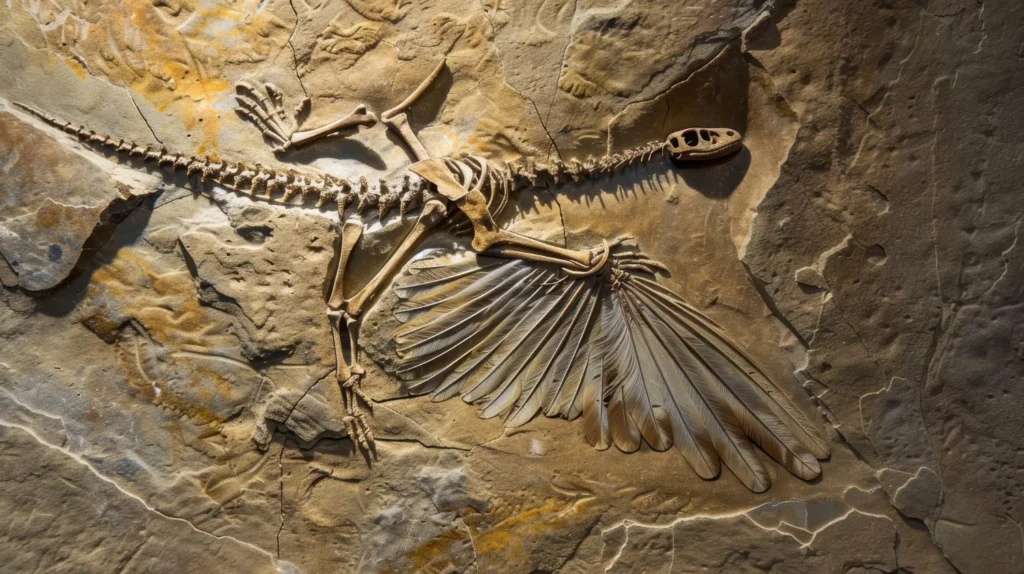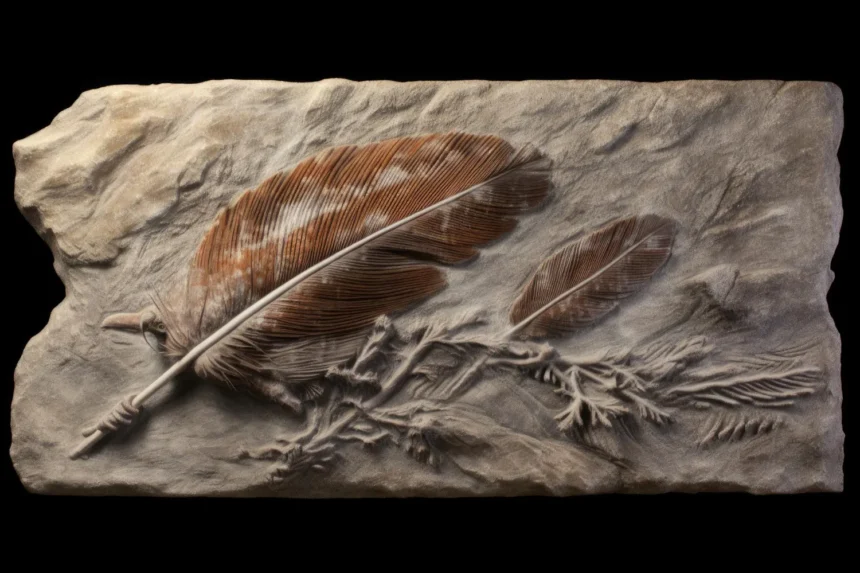Introduction
The findings of fossil feathers opened a new chapter in the history of avian evolution and the complex story of life on Earth. These fragile structures, which can be difficult to preserve, provide crucial information about the morphology, behavior, and ecology of past birds and feathered dinosaurs. A recent discovery—a 30,000-year-old vulture feather perfectly preserved in volcanic rock—exposed a one-of-a-kind mode of fossilization, emphasizing yet another way that volcanic activity preserves soft tissues.
Read more: What is a Fossil? Explore 5 Facts About Earth’s Most Incredible Prehistoric Wonders
The Remarkable Discovery
One feather fossil that was discovered in 1889 near Rome, Italy, was preserved in volcanic rock by a local landowner. Forgotten at first, this specimen has recently been subjected to meticulous analysis, disclosing excellent preservation down to the microscopic degree. The feather belonged to a vulture species that glided the skies of central Italy during the Late Pleistocene epoch, around 30,000 years ago.
Read more: Facts About Igneous Rocks: 7 Interesting Things About the fiery blocks
How Volcanic Ash Became an Unexpected Preservative
Volcanic eruptions are usually destructive, but they can serve a useful purpose under certain circumstances — in helping preserve organic materials. The quick loss of small volcanic ash can generate an anoxic territory, blocking decay and guarding stays from scavengers. About the vulture feather, it appears that the carcass was quickly buried in an ash-rich volcanic flow. That set up a “very conducive environment” for fast mineralization, with the zeolite nanocrystals reproducing the structure of the feather within days to weeks, preserving it in remarkable detail.
Read more: Unexpected Impacts: 3 Ways Weathering of Rocks Alters Our World
The Mechanism of Feather Fossilization
There are two main mechanisms in how fossil feathers are occluded: they can be preserved as carbonaceous films or through mineral replication. These processes help preserve the structure, texture, and in some cases, pigmentation of the original feathers, allowing scientists to glean important information about prehistoric bird species and feathered dinosaurs.
- Carbonaceous Films
This preservation happens when organic material breaks down, creating a slick layer of carbon. After millions of years, biological material chemically transforms under heat and pressure, shaking off volatile compounds—holding onto a carbon memory. The resulting fossil shows a dark outline of the original feather, with the fine-scale details of barbs and shafts preserved. This occurs frequently in fossil-rich deposits like the Solnhofen Limestone in Germany, where the feathers of Archaeopteryx were preserved.
Read more: Facts About Sedimentary Rocks: 7 Interesting Things You Never Knew About the Rocks Beneath You
- Mineral Replication
In this process, minerals literally take the place of the feather’s organic material on a micro-structural scale. Silica, calcium phosphate, or iron compounds slowly permeate the feather structures, preserving them in three-dimensional detail. This process can be fastened with the role of volcanic ash, and in the case of the recently uncovered vulture feather fossil, zeolite advances were mirrored in the morphology of the feather. Mineral replication preserves shape, unlike carbon films (but rather like hair) which is why this study has been so important for studying the microanatomy of feathers.

Read more: CHEMICAL WEATHERING: Nature’s Incredible Power to Transform Landscapes
These processes help shed light on the evolutionary history of ancient birds and their relationship with living descendants. The remarkable phenomenon of feather fossilization has not only exposed structural anatomy, but also details of color pattern, function, and evolutionary transition.
It is of the latter kind that the vulture feather preservation is. The collision of ash and water resulted in zeolite nanocrystals precipitating out in a cubic pattern that precisely mimicked the microscopic structure of the feather.
Implications for Paleontology
The finding expands our knowledge about fossils, especially regarding soft tissues such as feathers. It highlights the ability of volcanic deposits to conserve fine biological detail, providing new avenues of research in the field of paleontology. These findings can give a new understanding of the evolution of feathers, their structural evolution, and their functions in ancient species.”
Feathers in the Fossil Record
Feathers have played a central role in the research behind links between dinosaurs and present-day birds. Notable examples include:
- Fossil feather of Archaeopteryx: The first known fossil feather belonged to Archaeopteryx, the isolated fossil feather was discovered in Jurassic limestone deposits in Solnhofen, Germany in 1861. It belongs to the upper major primary covert of Archaeopteryx.
- Sinosauropteryx: This small theropod possessed simple, hair-like feathers and provided evidence for the presence of feather-like structures in non-avian dinosaurs.
- Inkayacu: An ancient giant penguin from the Eocene period whose mummified feathers preserved details of the color and characteristics of early penguins.

Volcanic Ash and Remarkable Preservation
It is well-documented that volcanic ash preserves fossils. An example of this would be the Ashfall Fossil Beds in Nebraska, USA, which were formed from a volcanic eruption that covered a watering hole in ash and preserved many Miocene mammals. The fine ash formed an impermeable blanket that allowed paleontologists to extract entire skeletons in surprising articulation.
Read also: 7 Largest and Most Dangerous Volcanoes by Continent You Should Fear
Conclusion
The stunning preservation of the muscle on the vulture feather within the layer of volcanic rock demonstrates the complex interaction of geological and biological processes, but it also underscores the value of revisiting and studying previously dismissed specimens. Such finds deepen our understanding of the process of fossilization and can clear new paths toward investigating the history of life on Earth.
FAQs
1. How do fossil feathers form?
Fossil feathers form through carbonaceous films or mineral replication, where minerals like zeolite replace the feather’s structure, preserving intricate details.
2. Why is the volcanic preservation of a feather significant?
Volcanic ash creates an anoxic, mineral-rich environment that prevents decay, allowing delicate structures like feathers to fossilize with extraordinary detail.
3. What is the oldest known fossil feather?
The oldest known fossil feather belongs to Archaeopteryx, a 150-million-year-old species that represents a transitional form between non-avian dinosaurs and birds.
4. Can volcanic eruptions preserve other biological materials?
Yes, volcanic ash has preserved entire skeletons, plant imprints, and soft tissues by creating rapid burial conditions that prevent decomposition and scavenging.
5. What does the vulture feather fossil reveal about ancient environments?
It suggests that volcanic eruptions played a role in shaping ecosystems, influencing species survival, and occasionally preserving delicate biological structures.





